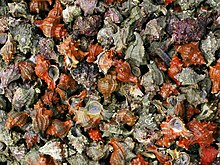| Hexaplex trunculus Temporal range:
| |
|---|---|

| |
| Hexaplex trunculus | |

| |
| Hexaplex trunculus | |
| Scientific classification | |
| Domain: | Eukaryota |
| Kingdom: | Animalia |
| Phylum: | Mollusca |
| Class: | Gastropoda |
| Subclass: | Caenogastropoda |
| Order: | Neogastropoda |
| Family: | Muricidae |
| Genus: | Hexaplex |
| Subgenus: | Trunculariopsis |
| Species: | H. trunculus
|
| Binomial name | |
| Hexaplex trunculus | |
| Synonyms | |
Murex armigerus Settepassi, 1970 (not available, published in a work which does not consistently use binomial nomenclature (ICZN art. 11.4))
| |
Hexaplex trunculus (previously known as Murex trunculus, Phyllonotus trunculus, or the banded dye-murex) is a medium-sized sea snail, a marine gastropod mollusk in the family Muricidae, the murex shells or rock snails. It is included in the subgenus Trunculariopsis.[1]
This species is a group of opportunist predatory snails that are known to attack their prey in groups. What is peculiar about this specific species is that they show no preference for the size of their prey, regardless of their hunger levels.[2]
The snail appears in fossil records dating between the Pliocene and Quaternary periods (between 3.6 and 0.012 million years ago). Fossilized shells have been found in Morocco, Italy, and Spain.[3]
This sea snail is historically important because its hypobranchial gland secretes a mucus used to create a distinctive purple-blue indigo dye. Ancient Mediterranean cultures, including the Minoans, Canaanites/Phoenicians, Hebrews, and classical Greeks created dyes from the snails. One of the dye's main chemical ingredients is red dibromo-indigotin, the main component of tyrian purple or tekhelet.[4] The dye will turn indigo blue, similar to the color of blue jeans, if exposed to sunlight before the dye sets.
- Subspecies
- Hexaplex trunculus trunculus (Linnaeus, 1758)
- ^ Cite error: The named reference
WoRMSwas invoked but never defined (see the help page). - ^ Guler, Mehmet; Lok, Aynur (2019). "Foraging Behaviors of a Predatory Snail (Hexaplex trunculus) in Group-Attacking". Turkish Journal of Fisheries and Aquatic Sciences. 19 (5): 391–398. doi:10.4194/1303-2712-v19_5_04. ISSN 1303-2712.
- ^ Fossilworks
- ^ Radwin, G. E.; D'Attilio, A. (1986). Murex shells of the world. An illustrated guide to the Muricidae. Stanford, CA: Stanford University Press. p. 93. 284 pp incl 192 figs. & 32 pls.